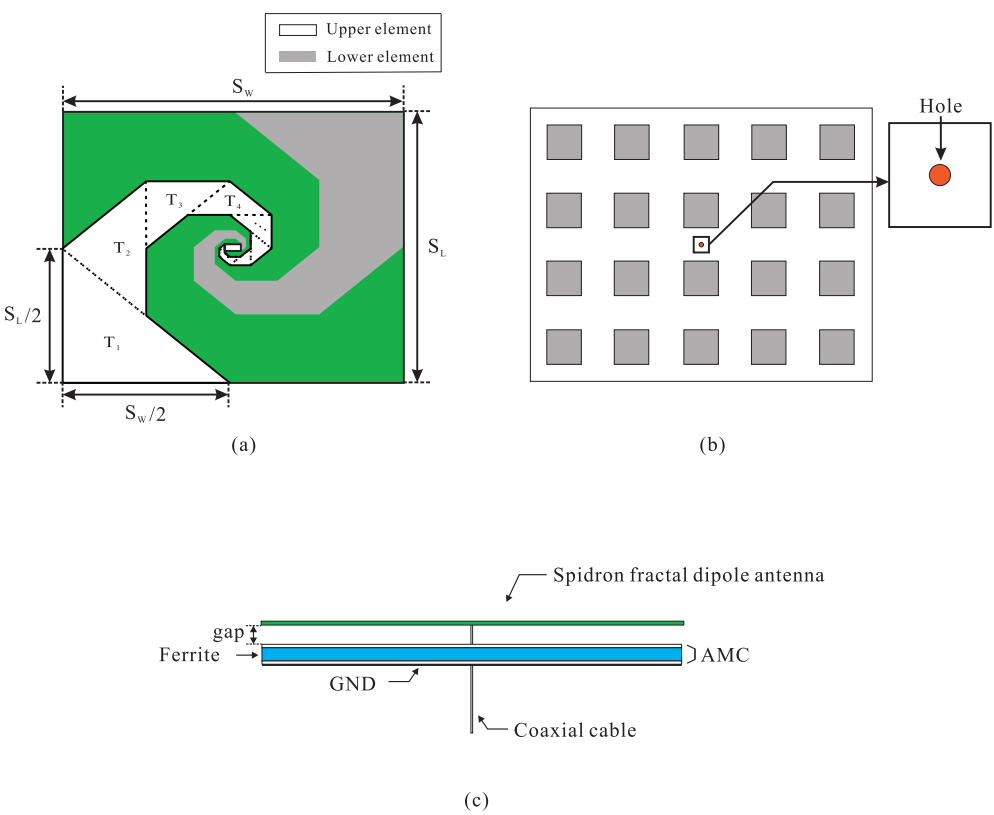Low-Profile Spidron Fractal Dipole Antenna with a Ferrite-Loaded Artificial Magnetic Conductor for Manpack Applications
Abstract
1. Introduction
2. Designs for the Artificial Magnetic Conductor and Antenna
2.1. A Ferrite-Loaded Artificial Magnetic Conductor Design
2.2. The Proposed AMC–Combined Spidron Fractal Dipole Antenna
3. Experimental Verification
3.1. Experimental Results of the Designed Antenna with the Standalone AMC
3.2. Experimental Results of the Designed Antenna with the AMC on a Manpack
4. Conclusions
Author Contributions
Funding
Conflicts of Interest
References
- Austin, B.A.; Liu, W.C. Assessment of vehicle-mounted antennas for NVIS applications. IEEE Proc. Microw. Antennas Propag. 2002, 149, 147–152. [Google Scholar] [CrossRef]
- Park, W.B.; Park, Y.; Hwang, K.C. Ferrite-loaded Spidron fractal loop VHF antenna for UAV applications. Appl. Sci. 2020, 10, 5392. [Google Scholar] [CrossRef]
- Chen, A.; Jiang, T.; Chen, Z.; Su, D. A novel low-profile wideband UHF antenna. Prog. Electromagn. Res. 2011, 121, 75–88. [Google Scholar] [CrossRef]
- Mattioni, L.; Marrocco, G. Design of a Broadband HF Antenna for Multimode Naval Communications—Part II: Extension to VHF/UHF Ranges. IEEE Antennas Wirel. Propag. Lett. 2007, 6, 83–85. [Google Scholar] [CrossRef]
- Smith, R.C.; Ignatenko, M.; Filipovic, D.S. Design of small loop antennas for on-the-move HF manpack radios. In Proceedings of the 2016 IEEE International Symposium on Antennas and Propagation (APSURSI), Fajardo, PuertoRico, 26 June–1 July 2016. [Google Scholar]
- Mi, S.; Lee, Y.H.; Shen, Z. Ferrite Coating Design for Near-Ground HF Bowtie Antenna. IEEE Trans. Antennas Propag. 2017, 65, 2074–2078. [Google Scholar] [CrossRef]
- Ren, Y. Low-profile wearable UHF antenna for portable radios and radar applications. In Proceedings of the 2011 XXXth URSI General Assembly and Scientific Symposium, Istanbul, Turkey, 13–20 August 2011. [Google Scholar]
- Min, K.-S. Multiband Cross-Shaped Inverse Triangular Notch Antenna for Radio Shadow Zone Communication. J. Electromagn. Eng. Sci. 2020, 20, 320–326. [Google Scholar] [CrossRef]
- Shin, H.; Oh, H. UHF-Band TV Transmitter for TV White Space Video Streaming Applications. J. Electromagn. Eng. Sci. 2019, 19, 227–233. [Google Scholar] [CrossRef]
- Lee, S.; Yoon, H.; Baik, K.-J.; Jang, B.-J. Emulator for Generating Heterogeneous Interference Signals in the Korean RFID/USN Frequency Band. J. Electromagn. Eng. Sci. 2018, 18, 254–260. [Google Scholar] [CrossRef]
- Ha, S.-G.; Cho, J.; Lee, J.; Min, B.-W.; Choi, J.; Jung, K.-Y. Numerical Study of Estimating the Arrival Time of UHF Signals for Partial Discharge Localization in a Power Transformer. J. Electromagn. Eng. Sci. 2018, 18, 94–100. [Google Scholar] [CrossRef]
- Ko, D.-O.; Woo, J.-M. Design of a Small Radio Frequency Identification Tag Antenna Using a Corrugated Meander Line Applicable to a Drug Runout Sensor System. J. Electromagn. Eng. Sci. 2018, 18, 7–12. [Google Scholar] [CrossRef]
- Feresidis, A.P.; Goussetis, G.; Wang, S.; Vardaxoglou, J.C. Artificial magnetic conductor surfaces and their application to low-profile high-gain planar antennas. IEEE Trans. Antennas Propag. 2005, 53, 209–215. [Google Scholar] [CrossRef]
- Foroozesh, A.; Shafai, L. Investigation Into the Application of Artificial Magnetic Conductors to Bandwidth Broadening, Gain Enhancement and Beam Shaping of Low Profile and Conventional Monopole Antenna. IEEE Trans. Antennas Propag. 2011, 59, 4–20. [Google Scholar] [CrossRef]
- Gregoire, D.J.; White, C.R.; Colburn, J.S. Wideband Artificial Magnetic Conductors Loaded With Non-Foster Negative Inductors. IEEE Antennas Wirel. Propag. Lett. 2011, 10, 1586–1589. [Google Scholar] [CrossRef]
- Mohamed-Hicho, N.M.; Antonino-Daviu, E.; Cabedo-fabres, M.; Ferrando-Bataller, M. A Novel Low-Profile High-Gain UHF Antenna Using High-Impedance Surfaces. IEEE Antennas Wirel. Propag. Lett. 2015, 14, 1014–1017. [Google Scholar] [CrossRef]
- Bell, J.M.; Iskander, M.F.; Lee, J.J. Ultrawideband Hybrid EBG/Ferrite Ground Plane for Low-Profile Array Antennas. IEEE Trans. Antennas Propag. 2007, 55, 4–12. [Google Scholar] [CrossRef]
- Costa, F.; Genovesi, S.; Monorchio, A. On the Bandwidth of High-Impedance Frequency Selective Surfaces. IEEE Antennas Wirel. Propag. Lett. 2009, 8, 1341–1344. [Google Scholar] [CrossRef]
- Kwon, O.H.; Park, W.B.; Lee, S.; Lee, J.M.; Park, Y.M.; Hwang, K.C. 3D-Printed Super-Wideband Spidron Fractal Cube Antenna with Laminated Copper. Appl. Sci. 2017, 7, 979. [Google Scholar] [CrossRef]
- Trihn-Van, S.; Thi, T.N.; Yang, Y.; Lee, K.; Jung, K.; Hwang, K.C. High-Gain Waveguide-Fed Circularly Polarized Spidron Fractal Aperture Antenna. Appl. Sci. 2019, 9, 691. [Google Scholar] [CrossRef]
- MP2106-0M0. Available online: https://www.mouser.com/datasheet/2/987/MP2106-0M0-1650723.pdf (accessed on 21 September 2020).
- Cortes-Mendellin, G. Non-Planar Quasi-Self-Complementary Ultra-Wideband Feed Antenna. IEEE Trans. Antennas Propag. 2011, 59, 1935–1944. [Google Scholar] [CrossRef]
- Gou, L.; Wang, S.; Chen, X.; Parini, C. A Small Printed Quasi-Self-Complementary Antenna for Ultrawideband Systems. IEEE Antennas Wirel. Propag. Lett. 2009, 8, 554–557. [Google Scholar]
- OMNI-A0167. Available online: http://www.alarisantennas.com/wp-content/uploads/2017/06/brochures/OMNI-A0167%20Version%201.5.pdf (accessed on 21 September 2020).
- OMNI-A0245. Available online: http://www.alarisantennas.com/wp-content/uploads/2017/06/brochures/OMNI-A0245%20Version%201.2.pdf (accessed on 21 September 2020).










Publisher’s Note: MDPI stays neutral with regard to jurisdictional claims in published maps and institutional affiliations. |
© 2020 by the authors. Licensee MDPI, Basel, Switzerland. This article is an open access article distributed under the terms and conditions of the Creative Commons Attribution (CC BY) license (http://creativecommons.org/licenses/by/4.0/).
Share and Cite
Kwon, O.H.; Hwang, K.C. Low-Profile Spidron Fractal Dipole Antenna with a Ferrite-Loaded Artificial Magnetic Conductor for Manpack Applications. Appl. Sci. 2020, 10, 8843. https://doi.org/10.3390/app10248843
Kwon OH, Hwang KC. Low-Profile Spidron Fractal Dipole Antenna with a Ferrite-Loaded Artificial Magnetic Conductor for Manpack Applications. Applied Sciences. 2020; 10(24):8843. https://doi.org/10.3390/app10248843
Chicago/Turabian StyleKwon, Oh Heon, and Keum Cheol Hwang. 2020. "Low-Profile Spidron Fractal Dipole Antenna with a Ferrite-Loaded Artificial Magnetic Conductor for Manpack Applications" Applied Sciences 10, no. 24: 8843. https://doi.org/10.3390/app10248843
APA StyleKwon, O. H., & Hwang, K. C. (2020). Low-Profile Spidron Fractal Dipole Antenna with a Ferrite-Loaded Artificial Magnetic Conductor for Manpack Applications. Applied Sciences, 10(24), 8843. https://doi.org/10.3390/app10248843





